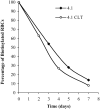Evidence for a protective role of the Gardos channel against hemolysis in murine spherocytosis
- PMID: 15855279
- PMCID: PMC1895196
- DOI: 10.1182/blood-2005-01-0368
Evidence for a protective role of the Gardos channel against hemolysis in murine spherocytosis
Abstract
It has been shown that mice with complete deficiency of all 4.1R protein isoforms (4.1-/-) exhibit moderate hemolytic anemia, with abnormal erythrocyte morphology (spherocytosis) and decreased membrane stability. Here, we characterized the Gardos channel function in vitro and in vivo in erythrocytes of 4.1-/- mice. Compared with wild-type, the Gardos channel of 4.1-/- erythrocytes showed an increase in Vmax (9.75 +/- 1.06 vs 6.08 +/- 0.09 mM cell x minute; P < .04) and a decrease in Km (1.01 +/- 0.06 vs 1.47 +/- 1.02 microM; P < .03), indicating an increased sensitivity to activation by intracellular calcium. In vivo function of the Gardos channel was assessed by the oral administration of clotrimazole, a well-characterized Gardos channel blocker. Clotrimazole treatment resulted in worsening of anemia and hemolysis, with decreased red cell survival and increased numbers of circulating hyperchromic spherocytes and microspherocytes. Clotrimazole induced similar changes in 4.2-/- and band 3+/- mice, indicating that these effects of the Gardos channel are shared in different models of murine spherocytosis. Thus, potassium and water loss through the Gardos channel may play an important protective role in compensating for the reduced surface-membrane area of hereditary spherocytosis (HS) erythrocytes and reducing hemolysis in erythrocytes with cytoskeletal impairments.
Figures





References
-
- Brugnara C. Erythrocyte membrane transport physiology. Curr Opin Hematol. 1997;4: 122-127. - PubMed
-
- Brugnara C. Red cell membrane in sickle cell disease. In: Forget B, Higgs D, Nagel R, Steinberg M, eds. Disorders of Hemoglobin. New York, NY: Cambridge University Press; 2001: 550-576.
-
- Olivieri O, Bonollo M, Friso S, Girelli D, Corrocher R, Vettore L. Activation of K+/Cl- cotransport in human erythrocytes exposed to oxidative agents. Biochim Biophys Acta. 1993;1176: 37-42. - PubMed
-
- Olivieri O, De Franceschi L, Capellini MD, Girelli D, Corrocher R, Brugnara C. Oxidative damage and erythrocyte membrane transport abnormalities in thalassemias. Blood. 1994;84: 315-320. - PubMed
Publication types
MeSH terms
Substances
Grants and funding
LinkOut - more resources
Full Text Sources
Molecular Biology Databases

